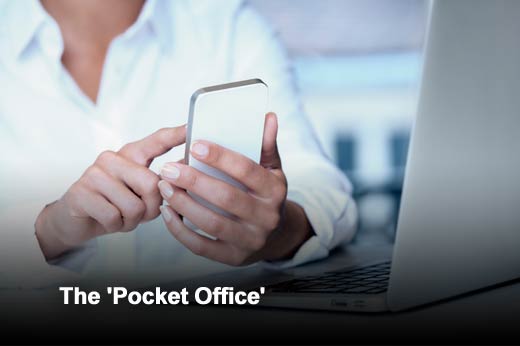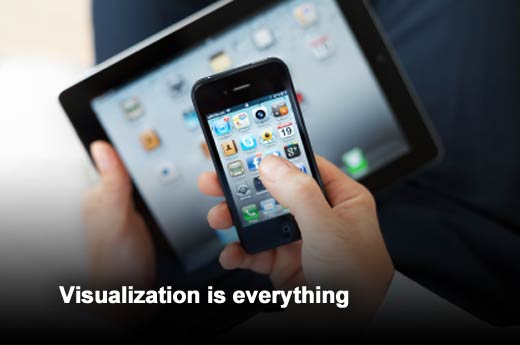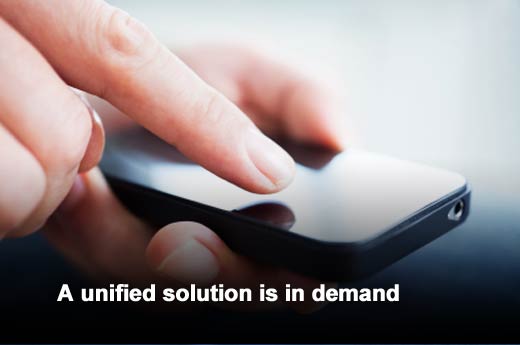The rise of mobile technology has significantly increased the use of personal devices in the workplace. In fact, personal “pocket office” devices tucked discreetly inside a purse or coat pocket are the tools powering many of today’s business professionals.
Yet, a surprising number of businesses continue to neglect addressing the “pocket office” in an official capacity — 60 percent of companies in 2013 had no personal device policy in place. Businesses that do create formal policies often focus on restricting usage and struggle to balance employee expectations with the need for security and a consistent company standard of communication.
Whether companies like it or not, the proliferation of mobile devices in the workplace will only grow, as employees desire the same mobile-driven productivity professionally that they enjoy personally. The time is ripe for businesses to harness the mobile tide and use it to empower productivity, rather than fight the current. In this slideshow, Rony Zarom, founder and CEO of Watchitoo, discusses four reasons why the “pocket office” movement is not only inevitable, but also an incredible opportunity to energize your business in 2015.
Click through for reasons why the “pocket office” movement is not only inevitable, but also an incredible opportunity to energize your business in 2015, as identified by Rony Zarom, founder and CEO of Watchitoo.
Mobile usage on the rise
Today, most if not all business is conducted on the Web, and increasingly on mobile devices. A recent KPCB 2014 Internet Trends Report reveals that mobile usage now accounts for 25 percent of all Web traffic, while highlighting declining storage and usage costs. With cloud storage and bandwidth prices dropping an annual 38 and 27 percent, respectively, the cost of owning and operating a “pocket office” device is no longer an issue.
It’s also never been easier to utilize professional Web-based software and cloud-computing services. Objects stored on Amazon Web Services, for example, roughly doubled in number from 2012 to 2014. The increasing popularity of Web-based productivity software such as Asana and Basecamp, not to mention browser-based email services such as Gmail, fuel this movement.
Mobile data has historically been a significant driver of storage and bandwidth costs in a media-rich digital world. But with issues of cost and accessibility increasingly out of the picture, reasons to embrace the “pocket office” outweigh former disincentives. These numbers show that mobile is the new frontier to which businesses must look because employees are already there.
People want their own technology
Personal technology encourages the consumer to customize solutions to fit their individual needs. Thanks to powerful personal mobile tools from technology giants like Apple, Android, Microsoft and Google, today’s professionals feel empowered (or perhaps entitled) to exercise that same mobile freedom in the workplace – an expectation which, if not met, can result in a productivity lull caused by employees spending time adjusting to tools they feel are clunky or non-intuitive.
Businesses can help circumvent such technology clashes by openly acknowledging the issue. Establish an explicit bring-your-own-device (BYOD) policy around how personal devices fit into the company’s IT structure. BYOD can certainly raise security issues for some companies, which only reinforces the need to openly address the issue with a clear policy and mobility management software. In cases where personal device use is limited, seek feedback from employees on their preferred software and tools – many of which may have enterprise versions that will provide a similar experience.
Visualization is everything
Consider the social media superstars that have risen in the last year: Snapchat, Instagram and WhatsApp. What do they have in common? Photo and video sharing. More specifically, mobile photo and video sharing are dominating the way we live. Not only does mobile viewing now account for 40 percent of YouTube watch time, today’s visual Web grows with 1.8 billion images uploaded from a combination of mobile and Web devices every day.
People crave visual communication in their personal lives, and a similar shift is taking place in the professional world. In fact, 71 percent of HR professionals reported the use of video to facilitate communication within the company. The next step for businesses using video collaboration is to find mobile solutions that allow employees to collaborate seamlessly through their “pocket office” device. Any videoconferencing solution worth its mettle today has mobile capabilities – consider taking advantage of those offerings.
A unified solution is in demand
Businesses typically utilize individual tools to accomplish specific elements of the collaborative process. Cloud storage services like Dropbox or Google Drive and screenshare apps like Join.me or Screenhero let professionals collaborate on documents and share media while videoconferencing, calling, texting, chatting or emailing.
To predict how professional collaboration will evolve, look to the realm of consumer technology. What you’ll see is the unification of previously separate mobile apps and tools into a single platform. Snapchat did it with their recent addition of text chat and videoconferencing features, and Apple is further driving the trend with updates incorporating storage and messaging features reminiscent of widely used tools like DropBox, WhatsApp and Voxer.
A unified solution is in demand
The enterprise world is approaching a similar turning point marked by the emergence of comprehensive “all-in-one” communication and collaboration solutions, which unite the tools professionals already use. Whether this is via “app constellations,” collections of popular apps bought up by large mobile app companies and synched up to work tightly together, or a single app that seamlessly integrates all the purpose-built functions performed by separate apps, the end effect is a unified solution accessible on any device. Many employees are primed to use these new mobile-driven platforms productively because they’ve already been through the transition once in their personal lives.
The proliferation of technology and mobile accessibility will only continue to blur the lines between personal and enterprise device usage. Businesses that welcome the BYOD movement and empower their “pocket office” users will be poised to reap the benefits of increased employee productivity and morale. Those that resist adopting formal policies will quickly become obsolete.








